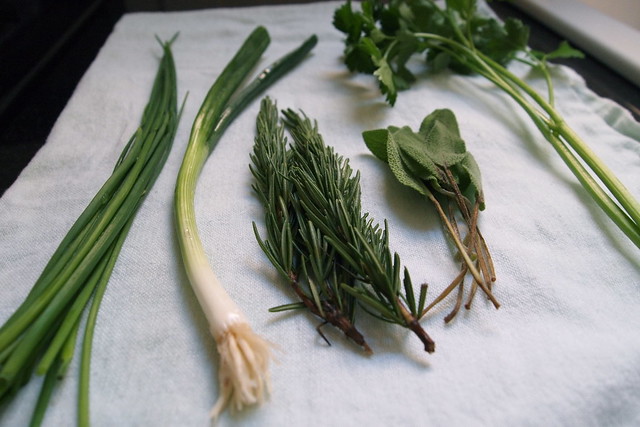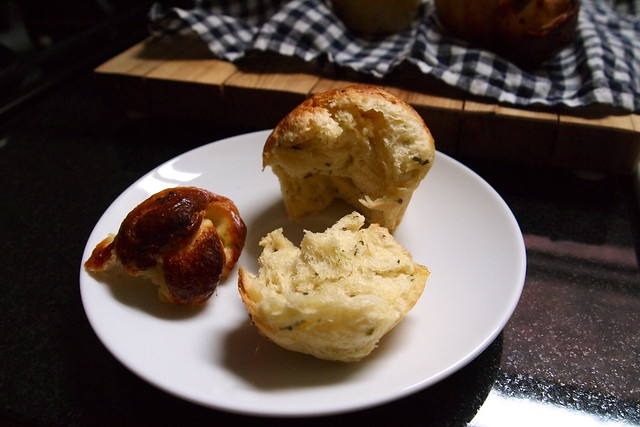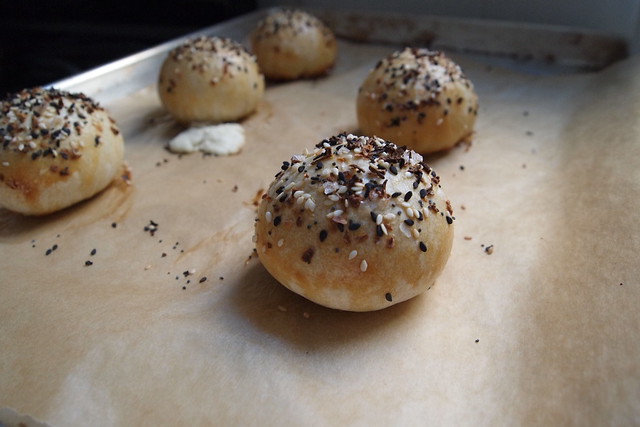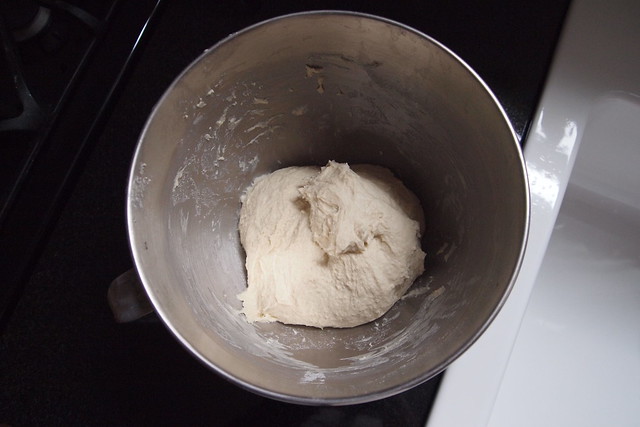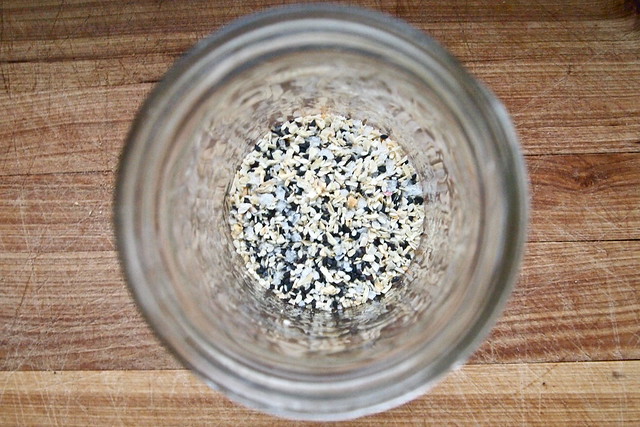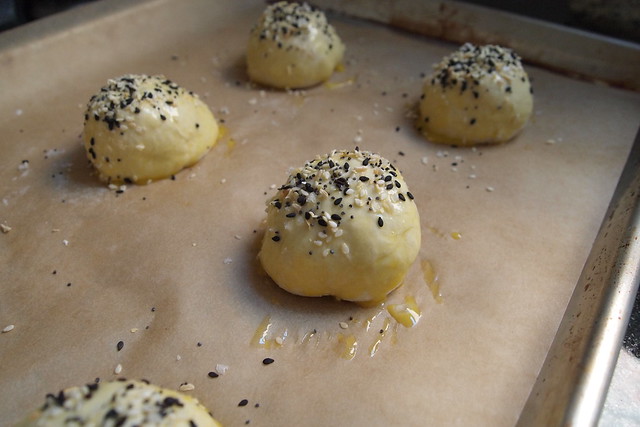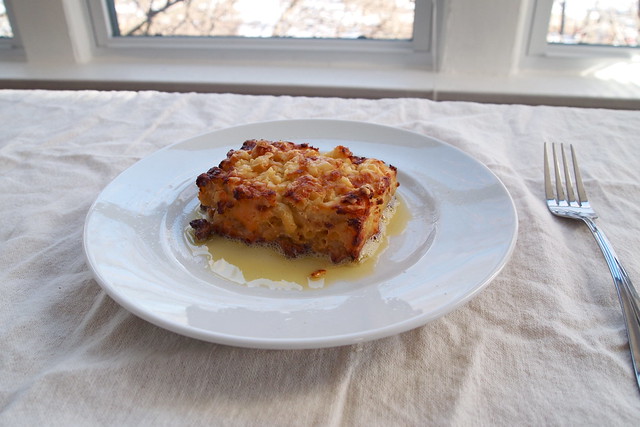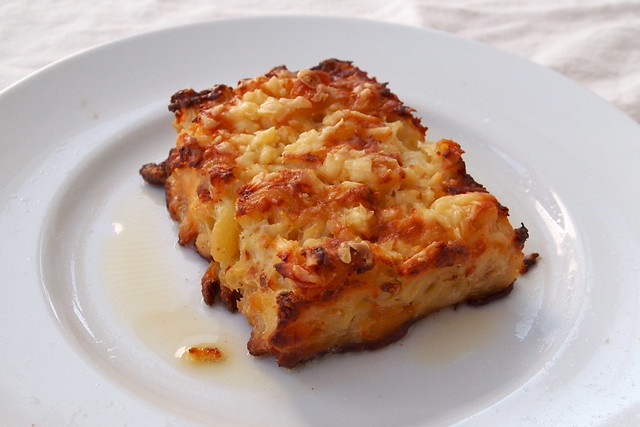I don't often get nostalgic about my undergraduate days. I'll admit it--I was an awkward, geeky kid coming out of high school. I was nowhere near ready for the droves of rowdy frat-boy types, the 11 am beer pong, the near constant party going on somewhere down the hall. This, of course, wasn't all there was to college, but when I lived in a dorm it seemed like it, and I was miserable. It took me a long while to find my place.
But one of the things I do remember fondly about those days (once I found a real place to live) is the splendid bakery downtown, Pan Chancho. Octavian and I would often wander in on Sunday afternoons to admire the rows of burnished sourdough boules and enjoy a cup of soup. I was doing most of our baking at home at the time, but there were a few things we always found hard to resist taking with us, like a couple of the savoury brioches. They were our favourite--lofty, buttery, herb-flecked--and just perfect with a sharp, lemony salad on a warm day. When it came time to move, I knew I'd miss them.
And clearly, I still haven't stopped thinking about those brioches. When Octavian and I were visiting this past December and popped into Pan Chancho, I made a beeline for the cookbooks. The bakery had published a collection of its recipes a few years ago, including one for the savoury brioches. I was determined to have those brioches, wherever I happened to be.
Getting the recipe to work for me took some tinkering. The translation from professional bakery to home kitchen has got to be a little tricky. So, while the first attempt was a little disappointing, the second--when I did what made the most sense to me--turned out brioches just as we remembered them--gleaming, golden, buttery, and tender.
If there's anything challenging about making brioches à tête like these (tête is just French for head), it's in the shaping. You want to make each round of dough as smooth and uniformly round as possible, and you want to place each tête dead-centre on top of its round. (You also don't want to handle the dough for too long and have the butter melt out on you.) Imperfections will be obvious once the brioches hit oven and start rising. Misaligned and unevenly shaped têtes will bake off-centre. (You can see from my photos that I haven't quite mastered the technique!) It just takes a little practice, and even if your brioches are a bit wonky looking, I don't see anyone complaining once they've taken a bite or two.
I planned to have the brioches with a modest soup over a few lunches, but I never quite got around to making any soup before all of the brioches disappeared. (We gave some away...I didn't eat all of them!) But I can say that these brioches are not out of place at breakfast and definitely make for an outstanding afternoon snack. I can even see them taking the place of dinner rolls if anyone wants to have me over for something that needs a little mopping up.
Savoury Brioche
Adapted, somewhat liberally, from The Pan Chancho Cookbook
Note: Mixing. It might be possible to mix the dough by hand, but I wouldn't recommend it. It will be difficult to pull the dough together, I think, and using your hands to knead the dough will warm the butter too much. Shaping. It takes a bit of practice to get the technique down for shaping the brioches. Alternatively, you can use the method that Dorie Greenspan uses here for bubble-top brioches, which is more forgiving.
375-500 g / 3-4 cups all-purpose flour
1 teaspoon fine sea salt
3 tablespoons sugar
2 sticks / 225 g unsalted butter, soft but still cool
5 large eggs
1 tablespoon instant yeast
1 tablespoon fresh Italian parsley, finely chopped
1 teaspoon fresh sage, finely chopped
2 teaspoons fresh chives, finely chopped
2 teaspoons rosemary, finely chopped
1 scallion, thinly sliced
60 g sharp cheddar, grated (about a 1/2 cup)
1/2 teaspoon freshly ground black pepper
1 large egg + 1 teaspoon water
Sift 375 g / 3 cups flour, the salt, and the sugar together. In a stand mixer fitted with a paddle attachment, cream the butter. Paddle in three of the eggs and scrape down the bowl. Incorporate the flour mixture at low speed, 1 cup at a time, and scrape down the bowl. Paddle in the remaining eggs at medium speed, one at a time. Add in the yeast and beat for 1-2 minutes. The dough should have pulled away from the sides the bowl at this point. If it's too wet and hasn't, mix in as much of the remaining flour as necessary on low.
Re-fit the stand mixer with the dough hook and knead the dough at medium-low speed for about 5 minutes. Knead in the herbs, cheese, and pepper at low speed. The dough should be smooth and elastic enough to pass the windowpane test. Press it into an even rectangle and wrap it tightly in plastic wrap. Refrigerate for 6 hours or overnight to firm up the butter.
Butter 16 of the cups in two muffin tins or 16 small brioche moulds if you have them. Place the dough on a lightly floured surface. Divide into 16 equal pieces, about 65-70 g each. Cut a bit of dough off each piece, about 1/5 of the total, for the tête. You don't want the tête too small, or it will dry out while baking.
Working quickly, shape all 32 pieces into rounds--cup your hands around each and press the edges of your palms into the edges of the dough and pull them in and towards the work surface, rotating the dough and repeating this motion until you have a smooth, even round; pinch the round from the bottom to tighten it. Place the large rounds into the greased muffin cups seam-side down. Press a well 3/4 of an inch deep into the centre of each round. Gently press a tête into each well. Cover with a damp tea towel and let rise for about 90 minutes or until doubled in size. The brioches should pretty much fill the muffin cups, their têtes clearing the tin.
Meanwhile, preheat the oven to 375 degrees F. Beat the remaining egg with the water for egg wash and brush the brioche. Bake for 18-20 minutes. The brioche should be golden and their têtes a deep mahogany. Unmould immediately and cool on a wire rack for at least 10 minutes. The brioche are best eaten the day they're baked but will keep for another day in a zip-top bag.
Makes 16 brioches.


